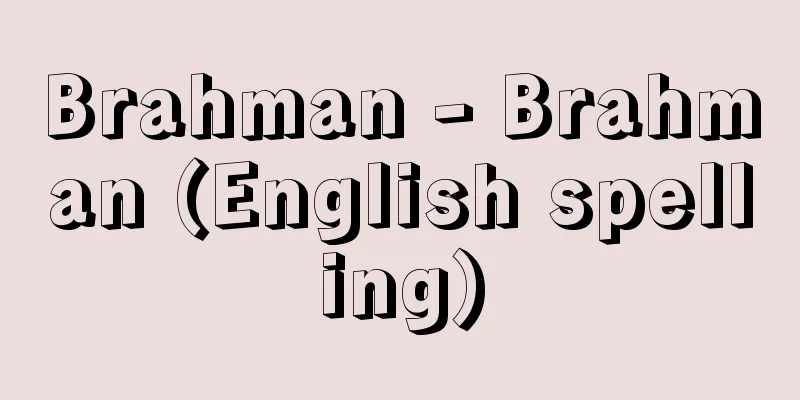Brahman - Brahman (English spelling)

|
A term in Indian philosophy indicating the "highest principle of the universe." Translated as "Bon," it is a concept that is particularly important in the Upanishads and the Vedanta school. The theory that the original meaning was the "word of the Vedas," which have sacred magical powers, is widely supported, but there are also theories that the original meaning is in "heavenly fire," "mystery of the universe," or the "idea of power" that is the basis of all things, and there is no consensus. The ancient Rig-Veda was the beginning of speculation about the unifying principle of the universe, and hymns such as Brahmanaspati (the prayer master) as the creator of the world and hymns that explain the origin of all things from early man appeared. Then, in the Atharva-Veda, life force (prana), time (kara), passion (kama), and the support of all things (skamba) are considered to be the highest principles, and through the Brahmanas, which consider Prajapati (the Creator) to be the fundamental principle, in the Upanishads, Brahman came to occupy the position of the highest principle. The neutral principle Brahman was eventually identified with the personal supreme principle Atman, and the theory of the unity of Brahman and Atman (the idea of oneness of Brahman and Atman) was established. The Vedanta school, which inherited this theory, aimed to recognize Brahman and attain liberation, and focused on how to explain the relationship between the one and only Brahman and the diverse and changing phenomenal world. The representative philosopher Shankara preached the falsehood of the phenomenal world and advocated the doctrine of non-dualism. Various other theories were asserted, such as Bhaskara's theory of non-uniformity and Ramanuja's theory of the non-dualism of the determined, and the theory of Brahman became a central issue in Indian philosophy. [Teruyoshi Matsumoto] [Reference] |Source: Shogakukan Encyclopedia Nipponica About Encyclopedia Nipponica Information | Legend |
|
「宇宙の最高原理」を示すインド哲学の術語。「梵(ぼん)」と訳され、とくにウパニシャッド文献およびベーダーンタ学派において重視される概念である。神聖な呪力(じゅりょく)をもつ「ベーダの語」を原義とみる説が広く支持されたが、「天上の火」「宇宙の謎(なぞ)」、万物のよりどころとなる「力の観念」などに原意を求める説もあり、定説をみない。古く『リグ・ベーダ』において宇宙の統一的原理を求める思索が開始され、ブラフマナスパティ(祈祷主(きとうしゅ))を世界創造者とする賛歌、原人からの万物発生を説く賛歌などが現れている。ついで『アタルバ・ベーダ』で、生気(プラーナ)、時間(カーラ)、愛欲(カーマ)、万有の支柱(スカンバ)などが最高原理とされ、プラジャーパティ(造物主)を根本原理とみるブラーフマナ文献を経て、ウパニシャッド文献に至って、ブラフマンが最高原理の位置を占めるに至った。中性原理ブラフマンは、やがて人格的最高原理アートマンと同一視され、ここにブラフマンとアートマンの一致説(梵我一如(ぼんがいちにょ)思想)が成立した。この説を継承するベーダーンタ学派は、ブラフマンを認識して解脱(げだつ)を得ることを目的としており、唯一無二のブラフマンと、雑多に現れ変化する現象界との関係をいかに説明するかということに力を注いだ。代表的哲人シャンカラは、現象界の虚妄を説いて不二一元論(ふにいちげんろん)を唱えた。そのほかバースカラの不一不異論(ふいつふいろん)、ラーマーヌジャの被限定者不二一元論など種々の説が主張され、ブラフマン論はインド哲学の中心的課題となった。 [松本照敬] [参照項目] |出典 小学館 日本大百科全書(ニッポニカ)日本大百科全書(ニッポニカ)について 情報 | 凡例 |
>>: Brahmaputra River (English spelling)
Recommend
Ukehi Shrine
...At Donko-in Temple of the Soto sect in Sako, t...
Veveyse
The Rhône flows into the lake from the eastern pa...
Gheorghe Şincai (English spelling)
1754‐1816 A Romanian historian and linguist from T...
Orfanel, Jacinto
1578-1622 Spanish missionary. Born November 18, 1...
Ollivier, E. (English spelling) OllivierE
...the political system that followed the Second ...
Kountche, S. (English spelling) KountcheS
… [Politics] Niger was the country most affected ...
Muscovite - Shiroumo
Along with biotite, this is the most widely distri...
Fass
…Here, I will only give a few examples that are e...
Hans-Georg Gadamer
One of the leading contemporary German philosophe...
Karakozov incident - Karakozov incident
The incident occurred on April 4, 1866, when Russi...
Fujimori Seikichi
Novelist and playwright. Born on August 28, 1892,...
Campbell, J.
…Such hero myths developed in the areas of ancien...
Tendai sect
It is a representative sect in Chinese and Japane...
Centranthera cochinchinensis (Lour.) Merr.ssp.lutea (Hara) Yamazaki
An annual plant of the Scrophulariaceae family tha...
Dump truck
...There are self-propelled ones (motor scrapers)...









